
A spinet is a smaller type of harpsichord or other keyboard instrument, such as a piano or organ.

A spinet is a smaller type of harpsichord or other keyboard instrument, such as a piano or organ.
When the term spinet is used to designate a harpsichord, typically what is meant is the bentside spinet, described in this section. For other uses, see below.
The bentside spinet shares most of its characteristics with the full-size instrument, including action, soundboard, and case construction. What primarily distinguishes the spinet is the angle of its strings: whereas in a full-size harpsichord, the strings are at a 90-degree angle to the keyboard (that is, they are parallel to the player's gaze); and in virginals they are parallel to the keyboard, in a spinet the strings are at an angle of about 30 degrees to the keyboard, going toward the right. It is considered a half-size harpsichord.
The case of a bentside spinet is approximately triangular. The side on the right is usually bent concavely (hence the name of the instrument), curving away from the player toward the right rear corner. The longest side is adjacent to and parallel with the bass strings, going from the right rear corner to a location on the player's left. The front side of the spinet contains the keyboard. Typically, there are very short sides at the right rear and on the left, connecting the bentside to the long side and the long side to the front.
The other major aspect of spinet design is that the strings are arranged in pairs. The gap between the two strings of a pair is about four millimetres, and the wider gap between pairs is about ten. The jacks (which pluck the strings) are arranged in pairs as well, placed in the wider gap. They face in opposite directions, plucking the adjacent string on either side of the wider gap. The fact that half of the gaps are four millimetres instead of ten makes it possible to crowd more strings together into a smaller case.

The disadvantage of the paired design is that it generally limits the spinet to a single choir of strings, at eight-foot pitch, although a double-strung spinet by John Player is known. [1] In a full-size harpsichord, the registers that guide the jacks can be shifted slightly to one side, permitting the player to control whether or not that particular set of strings is sounded. This is impossible in a spinet, due to the alternating orientation of the jacks. For an exception to this point, see "spinettone", below.

The angling of the strings also had consequences for tone quality: generally, it was not possible to make the plucking points as close to the nut as in a regular harpsichord. Thus spinets normally had a slightly different tone quality, with fewer higher harmonics. Spinets also had smaller soundboards than regular harpsichords, and normally had a weaker sound. For these reasons, the spinet was normally only a domestic instrument, purchased to save money and conserve domestic space.

Harpsichord historian Frank Hubbard wrote in 1967, "the earliest [bentside] spinet known to me was made by Hieronymus de Zentis in 1631. It is quite possible that Zentis was the inventor of the type so widely copied in other countries." [2] He further notes that the spinet in France was sometimes called the épinette à l'italienne, supporting an Italian origin.
In England, builders included John Player, Thomas Barton, Charles Haward, Stephen Keene, Cawton Aston, and Thomas Hitchcock.
The spinet was later developed into the spinettone ("big spinet") by Bartolomeo Cristofori (1655–1731), the inventor of the piano. The spinettone incorporated multiple choirs of strings, with a disposition of 1 × 8 ft, 1 × 4 ft, and used the same ingenious mechanism for changing stops that Cristofori had earlier used for his oval spinet. The spinettone was a local success among the musicians of the Medici court, [3] and Cristofori eventually built a total of four of them. [4]
Spinets are occasionally made today, sometimes from kits, and serve the same purpose they always have, of saving money and space.

The pentagonal spinet was not a spinet in the sense given above, but rather a virginal; its strings were parallel to the keyboard. Typically, the pentagonal spinet was more compact than other types of virginals, as the pentagon shape arose from lopping off the corners of the original rectangular virginal design.
More generally, the word spinet was not always very sharply defined in former times, particularly in its French and Italian cognate forms épinette and spinetta. Thus, for example, when Bartolomeo Cristofori invented a new kind of virginals in 1688, he called it the "spinetta ovale", "oval spinet".
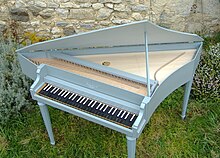
In earlier times when English spelling was less standardized, "spinet" was sometimes spelled "spinnet" or "spinnit". "Spinet" is standard today.
Spinet derives from the Italian spinetta, which in 17th-century Italian was a word used generally for all quilled instruments, especially what in Elizabethan/Jacobean English were called virginals. The specific Italian word for a virginals is spinetta a tabola. Likewise, the French derivation from spinetta, épinette, is specifically what the virginals is called in French, although the word is also used for any other small quilled instrument, whether a small harpsichord or a clavichord. In German, Spinett and Querflügel are used.
A dumb spinet is a manichord or "clavichord or clarichord", according to the 1913 edition of Webster's Dictionary .
The spinet piano, manufactured from the 1930s until recent times, was the culmination of a trend among manufacturers to make pianos smaller and cheaper. It served the purpose of making pianos available for a low price, for owners who had little space for a piano. Many spinet pianos still exist today, left over from their period of manufacture.
The defining characteristic of the spinet was its drop action (sometimes called indirect blow action). In this device, the keys did not engage the action directly; rather they pulled upward on rods called "stickers", which in turn pulled upward on levers located below the level of the keyboard, which in turn engaged the action. The stickers were sufficiently long that the hammer heads (the highest part of the action) ended up at roughly the same vertical level as the keyboard.
Thanks to the drop action, spinet pianos could be made very small; the top of a spinet rose only a few inches above the level of the keyboard itself (see image above). However, according to piano author Larry Fine, [5] the cost in quality was considerable. The stickers were "often noisy and troublesome". Moreover, to make room for them, the keys had to be made shorter, resulting in "very poor leverage" and thus a poor sense of touch and control for the player. Lastly, the very short strings of the spinet resulted in a narrow range of harmonics and thus in poor tone quality.
The spinet was also the bane of piano technicians. Concerning the difficulty of servicing them, Fine writes
Spinets ... are very difficult to service because even the smallest repair requiring removal of the action becomes a major ordeal. Each of the connecting stickers has to be disconnected and tied up to the action and all the keys have to be removed from the piano before the action can be lifted out. [6]
According to piano historian Arthur Loesser (1954), the first spinet piano was offered to the public in May 1935, by an American manufacturer Loesser does not identify. However, according to the Blue Book of Pianos, this manufacturer was Winter and Company (which eventually became part of the Aeolian-American Corporation) [7] who sold this piano as the Winter "Musette". [8] [9] The Musette, along with its spinet cousins, were initially a success, being the only kind of piano that many people could afford in the depths of the Great Depression. (According to Loesser, the price could be less than $300, "about twenty-five percent lower than ... a small upright of 1924.") Loesser notes that the spinet was not entirely new, as very small pianos had been manufactured at various times in the 19th century. [10]
After the 1930s, many people still continued to purchase spinets; a 1947 study showed that about 50 percent of all pianos sold during that production year were pianos strung vertically of 37 inches in height or less. [11] The spinet enjoyed decades of popularity after the 1930s, but production was halted in the early 1990s.
The spinet organ, a product of the mid-20th century, served the same function (domestic context, low cost) that was served by spinet harpsichords and spinet pianos. The spinet organ physically resembled a small upright piano, and presented simplified controls and functions that were both less expensive to produce and less intimidating to learn than other organs.

A harpsichord is a musical instrument played by means of a keyboard. This activates a row of levers that turn a trigger mechanism that plucks one or more strings with a small plectrum made from quill or plastic. The strings are under tension on a soundboard, which is mounted in a wooden case; the soundboard amplifies the vibrations from the strings so that the listeners can hear it. Like a pipe organ, a harpsichord may have more than one keyboard manual, and even a pedal board. Harpsichords may also have stop buttons which add or remove additional octaves. Some harpsichords may have a buff stop, which brings a strip of buff leather or other material in contact with the strings, muting their sound to simulate the sound of a plucked lute.
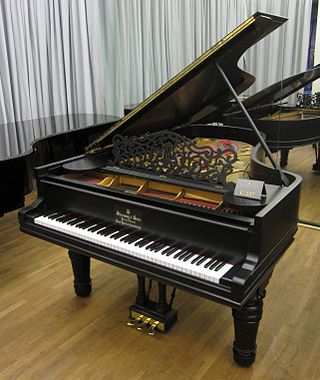
The piano is a keyboard instrument that produces sound when the keys are pressed. Most modern pianos have a row of 88 black and white keys: 52 white keys for the notes of the C major scale and 36 shorter black keys raised above the white keys and set further back, for sharps and flats. This means that the piano can play 88 different pitches, spanning a range of a bit over seven octaves. The black keys are for the "accidentals", which are needed to play in all twelve keys.

A plectrum is a small flat tool used for plucking or strumming of a stringed instrument. For hand-held instruments such as guitars and mandolins, the plectrum is often called a pick and is held as a separate tool in the player's hand. In harpsichords, the plectra are attached to the jack mechanism.

Bartolomeo Cristofori di Francesco was an Italian maker of musical instruments famous for inventing the piano.
The short octave was a method of assigning notes to keys in early keyboard instruments, for the purpose of giving the instrument an extended range in the bass range. The rationale behind this system was that the low notes F♯ and G♯ are seldom needed in early music. Deep bass notes typically form the root of the chord, and F♯ and G♯ chords were seldom used at this time. In contrast, low C and D, both roots of very common chords, are sorely missed if a harpsichord with lowest key E is tuned to match the keyboard layout. A closely related system, the broken octave, added more notes by using split keys: the front part and the back part of the (visible) key controlled separate levers and hence separate notes.

The virginals is a keyboard instrument of the harpsichord family. It was popular in Europe during the late Renaissance and early Baroque periods.

A clavicytherium is a harpsichord in which the soundboard and strings are mounted vertically facing the player. The primary purpose of making a harpsichord vertical is the same as in the later upright piano, namely to save floor space. In a clavicytherium, the jacks move horizontally without the assistance of gravity, so that clavicytherium actions are more complex than those of other harpsichords.
The Ruckers family were harpsichord and virginal makers from the Southern Netherlands based in Antwerp in the 16th and 17th century. Their influence stretched well into the 18th century, and to the harpsichord revival of the 20th.
The action of a string instrument that is plucked, strummed, or bowed by hand is the distance between the fingerboard and the string. In keyboard instruments, the action is the mechanism that translates the motion of the keys into the creation of sound.
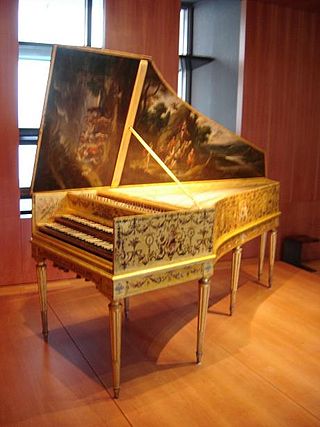
Pascal-Joseph Taskin was a Belgium-born French harpsichord and piano maker.
The oval spinet is a type of harpsichord invented in the late 17th century by Bartolomeo Cristofori, the Italian instrument maker who later achieved fame for inventing the piano. The oval spinet was unusual for its shape, the arrangement of its strings, and for its mechanism for changing registration.

The harpsichord was an important keyboard instrument in Europe from the 15th through the 18th centuries, and as revived in the 20th, is widely played today.
Americus Backers, sometimes described as the father of the English grand pianoforte style, brought the hammer striking action for keyboard instruments from his master Gottfried Silbermann's workshop in Freiburg to England in the mid-18th century. Unlike the eleven other ex-apprentices of Silbermann who followed him to England and built square pianos with his action, Backers developed Silbermann's action into a reliable, powerful and responsive form that he built into a grand harpsichord case and added two tonal effects – una corda and damper lift – activated by pedals built into the dedicated trestle stand, again his original innovation. This new instrument altered the landscape of English music, causing composers and musicians to consign the plucked string harpsichord and its music to history. It is upon Americus's design that the modern grand pianoforte we know today is based.

The spinettone was a kind of harpsichord invented in the late 17th century by Bartolomeo Cristofori, who was later the inventor of the piano. Other names for this instrument were spinettone da teatro, spinetta traversa.
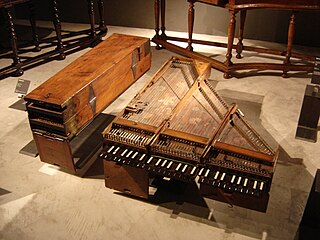
The folding harpsichord was a kind of harpsichord meant for travel. Since it could be folded up into a fairly compact space, it was more easily transported than a conventional harpsichord. The folding took place on hinges and was in the longitudinal dimension, preserving the tension on the strings. The folded instrument formed a package about the size of a large suitcase.
Leopoldo Franciolini (1844–1920) was an Italian antique dealer who was active in the late 19th and early 20th centuries. He is remembered as a fraudster who sold faked and altered historical musical instruments. To this day his work is a barrier to the scholarly study of instruments of the past.

Girolamo Zenti was an Italian harpsichord maker and organ builder in the 17th century. He is known as the probable inventor of the bentside spinet and for having traveled unusually extensively to practice his trade at the courts of Europe, including Rome, Florence, Paris, London and Stockholm.
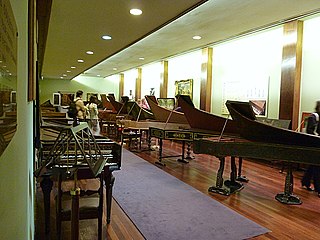
The Russell Collection is a substantial collection of early keyboard instruments assembled by the British harpsichordist and organologist Raymond Russell. It forms part of the Musical Instrument Museums collection of the University of Edinburgh, and is housed in St Cecilia's Hall. Its full name is the Raymond Russell Collection of Early Keyboard Instruments.